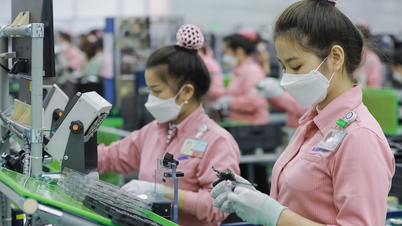Despite impressive growth over the past 10 years, Vietnam's hourly labor productivity remains lower than many countries in the region.
In a recent report, the World Bank said that over the past 30 years, Vietnam has been considered a global economic star with the fastest GDP growth rate in the world. From 1990 to 2021, Vietnam's GDP per capita increased at an average annual rate of 5.3%, faster than any economy in the region except China. This outstanding achievement was driven by three engines: rapid capital accumulation; abundant labor supply; high productivity growth.
However, the World Bank also noted that to maintain this economic miracle, the key that Vietnam needs to grasp is productivity growth.
Vietnam's labor productivity increased by 64% between 2010 and 2020, faster than all other countries in the region, mainly due to improvements in the business environment, improved human resources quality and larger FDI inflows. However, despite this growth, labor productivity remains much lower than that of its peers.
Data from the Asian Productivity Organization (APO) shows that in 2020, the production value per hour of labor of Vietnamese people only reached 6.4 USD, compared to 14.8 USD in Thailand and 68.5 USD in Singapore.
In addition, average total factor productivity (TFP) at the enterprise level increased by less than 2% in the 2014-2018 period, lower than that of many East Asian economies (IMF data 2022). TFP is an indicator reflecting production results thanks to improved efficiency in capital and labor use, technological innovation, management improvement, and skill improvement.
TFP growth also played a relatively small role in Vietnam's rapid GDP growth. OECD data shows that TFP contributed only about 1.5 percentage points to GDP growth in the 2015-2019 period.
Besides, according to the World Bank, Vietnam's economy has grown rapidly, but mainly thanks to FDI, with little spillover effect on domestic enterprises.
Although the number of domestic private enterprises has increased sharply over the past decade, domestic enterprises are often smaller, less efficient and less innovative than foreign-invested enterprises and are not well integrated into global value chains.
Most domestic private enterprises are micro, small, operating in relatively low-productivity sectors (eg retail, small restaurants) and simple manufacturing activities aimed at the domestic market, rather than exports. In terms of value added per worker, foreign-invested enterprises are nearly five times more productive and have much higher returns on assets and profits than domestic enterprises.
To improve, the World Bank said, it is possible to increase labor productivity through three channels, focusing especially on the participation of startups and innovation companies.
In the first channel, Vietnam needs to improve the efficiency of existing enterprises, including improving management practices, adopting new technologies, and enhancing access to markets and finance.
Next, Vietnam needs to reallocate resources across firms and industries from the less productive to the more productive; and allow more productive firms, mainly innovative startups, to enter and less productive firms to exit the market.
The focus should be on the participation of innovative startups, which can play a key role in creating high-quality jobs, creating new markets and disrupting existing markets, thereby boosting private sector productivity, according to the World Bank.
Duc Minh
Source link
































































































![[OCOP REVIEW] Bay Quyen sticky rice cake: A hometown specialty that has reached new heights thanks to its brand reputation](https://vphoto.vietnam.vn/thumb/402x226/vietnam/resource/IMAGE/2025/7/3/1a7e35c028bf46199ee1ec6b3ba0069e)










Comment (0)